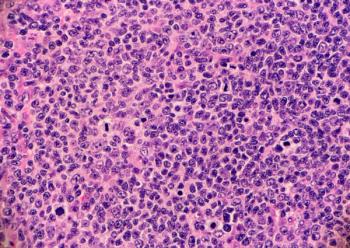Key Takeaways
- Missed Primary Endpoint at 36 Weeks. Efruxifermin did not significantly reduce fibrosis without worsening of MASH at week 36 compared to placebo, the trial's primary outcome.
- Potential Fibrosis Benefit at 96 Weeks. At 96 weeks, 29% of patients receiving the 50-mg dose achieved fibrosis improvement without MASH worsening, showing a 16% advantage over placebo.
- Support for Ongoing Phase III Studies. The long-term data signal meaningful trends in liver histology and metabolic markers, bolstering rationale for continued investigation in the SYNCHRONY Phase III program.
The Phase IIb SYMMETRY clinical trial (NCT05039450) evaluating the investigational fibroblast growth factor 21 (FGF21) analogue efruxifermin in the treatment of cirrhosis associated with metabolic dysfunction-associated steatohepatitis (MASH) fell short of the primary endpoint at week 36 but showed signs of a potential benefit across a 96-week treatment regimen.1,2
Efruxifermin Phase IIb Trial in MASH-Related Cirrhosis Shows Long-Term Potential Despite Early Miss
The trial results, published by The New England Journal of Medicine (NEJM), did indicate encouraging trends beyond 36 weeks, requiring further study in Phase III trials to confirm these findings and assess long-term safety and treatment outcomes, according to the study authors.
“In this phase 2b trial, the use of efruxifermin did not result in a significant reduction in fibrosis without worsening of MASH at week 36 (the primary outcome), as compared with placebo,” the study authors wrote in NEJM. “No formal hypothesis testing of secondary outcomes was conducted, so no statistical conclusions can be drawn. However, the results suggest the possibility of benefit for the 50-mg dose of efruxifermin on fibrosis reduction at 96 weeks. Efruxifermin also appeared to be associated with improvements in MASH-related histologic findings, noninvasive markers of liver injury and fibrosis, and markers of glucose and lipid metabolism.”1
SYMMETRY Trial Design Focused on Compensated Cirrhosis Due to MASH
Efruxifermin was developed to mirror the biological activity of FGF21, which has been found to regulate various metabolic pathways and cellular processes. Efruxifermin delivers consistent and balanced signaling through the FGF21 receptors in liver and adipose tissue, all of which are core drivers of disease progression.3,4
The drug is being evaluated in the Phase III SYNCHRONY program, which also includes the multicenter, randomized, double-blind, placebo-controlled SYNCHRONY Histology (NCT06215716) trial,5 SYNCHONY Real-World (NCT06161571) trial,6 and SYNCHRONY Outcomes (NCT06528314)7 clinical trial.
SYNCHRONY Histology is analyzing the efficacy and safety of efruxifermin in patients with biopsy-confirmed pre-cirrhotic MASH with fibrosis stages 2 and 3; SYNCHRONY Real-World is evaluating the safety and tolerability of efruxifermin in patients with non-invasively diagnosed MASH or metabolic dysfunction-associated steatotic liver disease with fibrosis stages 1 to 4; and SYNCHRONY Outcomes is evaluating efruxifermin for compensated cirrhosis due to MASH with fibrosis stage 4.
“Efruxifermin is an FGF21 analogue in development for the treatment of advanced fibrosis and cirrhosis caused by MASH,” the study authors wrote in NEJM. “It features a bivalent configuration consisting of two modified human FGF21 polypeptides fused to each fragment crystallizable (Fc) domain of homodimeric human immunoglobulin G1 (IgG1), which extends both pharmacokinetic and pharmacodynamic half-lives. In phase 2 trials involving patients with stage 2 or 3 fibrosis caused by MASH, efruxifermin reduced fibrosis and resolved MASH. Extending efruxifermin treatment from 24 to 96 weeks resulted in additional fibrosis regression, particularly in stage 3 fibrosis.”1
Trial Design and Patient Profile
- The randomized, placebo-controlled, double-blind SYMMETRY trial included 181 MASH patients with biopsy-confirmed compensated cirrhosis with stage 4 fibrosis.
- Patients were randomly assigned in a 1:1:1 ratio via an interactive-response system to receive 28 mg (n = 57) or 50 mg (n = 63) efruxifermin administered subcutaneously once weekly or matching placebo (n = 61).
- The primary outcome was reduction of at least one stage of fibrosis without worsening of MASH at week 36, with secondary outcomes that included the same outcomes at 96 weeks.
- At 36 weeks, 154 patients received a liver biopsy, with 134 patients receiving a liver biopsy at 96 weeks.
Key Findings Highlight 96-Week Fibrosis Improvement
- Results show that at 36 weeks, 13% of patients in the placebo cohort achieved reduced fibrosis without worsening of MASH compared to 18% of patients in the 28-mg efruxifermin cohort (difference from placebo after adjustment for stratification factors, 3 percentage points; 95% confidence interval [CI], –11 to 17; P=0.62) and 19% of patients in the 50-mg efruxifermin cohort (difference from placebo, 4 percentage points; 95% CI, –10 to 18; P=0.52).
- At week 96, reduced fibrosis without worsening of MASH was achieved in 11% of patients in the placebo cohort compared to 21% of patients in the 28-mg efruxifermin cohort (difference from placebo, 10 percentage points; 95% CI, –4 to 24) and 29% of patients in the 50-mg efruxifermin cohort (difference from placebo, 16 percentage points; 95% CI, 2 to 30).
- In terms of safety, gastrointestinal adverse events (AEs) were reported more frequently in the efruxifermin cohorts, but most AEs were deemed mild or moderate in nature.
Future Directions for Efruxifermin
“Cirrhosis caused by MASH remains a major unmet medical need for treatment. In this trial, efruxifermin did not have significant benefit regarding a reduction in fibrosis without a worsening of MASH at week 36,” the study authors concluded. “However, the trial duration of 96 weeks enabled identification of possible treatment effects that were not apparent at week 36. Longer studies in diverse populations will be necessary to evaluate clinical outcomes, safety, and generalizability of the findings and to assess benefits of longer-term treatment.”1
References
1. Noureddin M., et al. Efruxifermin in Compensated Liver Cirrhosis Caused by MASH. N Engl J Med 2025;392:2413-2424. DOI: 10.1056/NEJMoa2502242. VOL. 392 NO. 24.
2. A Study of Efruxifermin in Subjects With Compensated Cirrhosis Due to Nonalcoholic Steatohepatitis (NASH) (Symmetry). ClinicalTrials.gov identifier: NCT05039450. Updated April 9, 2025, Accessed June 26, 2025. https://clinicaltrials.gov/study/NCT05039450
3. Akero Therapeutics. Efruxifermin (EFX). Accessed June 26, 2025. https://akerotx.com/efruxifermin/
4. Akero Therapeutics. Clinical Trials Overview. Accessed June 26, 2025. https://akerotx.com/clinical-trials/
5. A Study Evaluating Efruxifermin in Subjects With Non-Cirrhotic Nonalcoholic Steatohepatitis (NASH)/Metabolic Dysfunction-Associated Steatohepatitis (MASH) and Fibrosis. ClinicalTrials.gov identifier: NCT06215716. Updated January 23, 2025. Accessed June 26, 2025. https://www.clinicaltrials.gov/study/NCT06215716
6. A Study Evaluating Efruxifermin in Subjects With Non-invasively Diagnosed Nonalcoholic Steatohepatitis (NASH)/Metabolic Dysfunction-Associated Steatohepatitis (MASH) and Nonalcoholic Fatty Liver Disease (NAFLD)/Metabolic Dysfunction-Associated Steatotic Liver Disease (MASLD). ClinicalTrials.gov identifier: NCT06161571. Updated January 17, 2025. Accessed June 26, 2025. https://www.clinicaltrials.gov/study/NCT06161571
7. A Study Evaluating Efruxifermin in Subjects with Compensated Cirrhosis Due to NASH/MASH. ClinicalTrials.gov identifier: NCT06528314. Updated December 16, 2024. Accessed June 26, 2025. https://clinicaltrials.gov/study/NCT06528314







.png)



.png)



.png)
.png)
